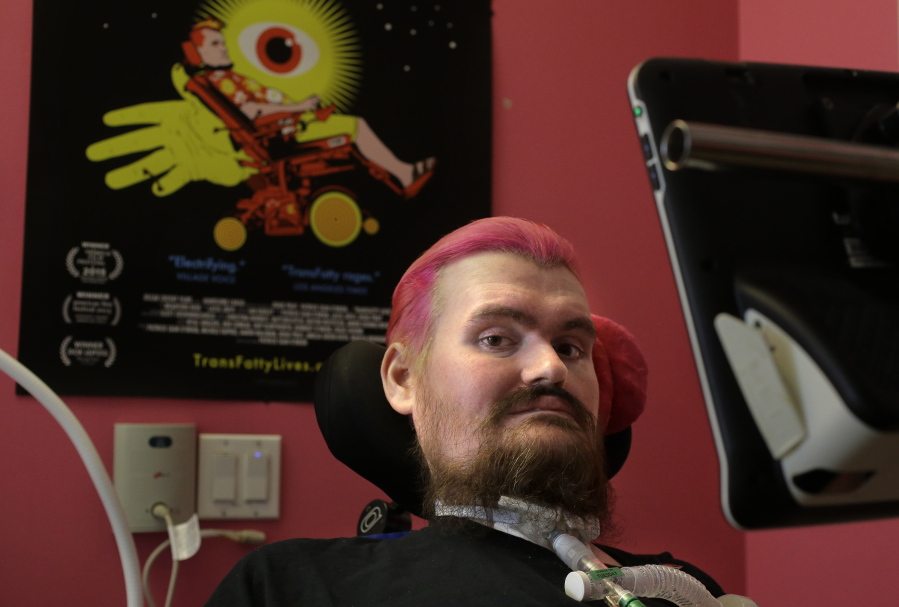CHELSEA, Mass. — Patrick O’Brien was a young, budding New York City filmmaker and DJ known as “TransFatty” when his legs suddenly started trembling uncontrollably. Walking became a struggle. He’d lose his balance and often fall down.
Then, in 2005, came the diagnosis: amyotrophic lateral sclerosis, or ALS. The 30-year-old native of Kensington, Md., was given two to five years to live.
But rather than let it defeat him, O’Brien — whose DJ name came from his love of junk food — turned the cameras on himself and wrote, directed and produced an acclaimed new documentary.
“TransFatty Lives” captures O’Brien’s rapid deterioration and the unexpected turns his life took over the next decade, including a whirlwind relationship that led to the birth of his son, Sean, and his eventual breakup with Sean’s mother.
No longer able to speak or move, O’Brien finished the documentary by communicating to his family and film collaborators Lasse Jarvi, Doug Pray and others using a computer system that lets him type out words through eye movements.
The film won the audience award for best documentary at last year’s Tribeca and Milan film festivals. It had a short theatrical release in New York and Los Angeles, and is available for download on digital platforms. A screening was held last Sunday at the Showcase Cinemas in Revere, Mass.
O’Brien, now 41 and living in a center for ALS patients in nearby Chelsea, said the response has been his “wildest dream come true.”
“We knew we had a story to share,” he wrote to The Associated Press last week using the same typing system that allowed him to complete the film. “Witnessing friends, family and strangers come together to help shoot, edit and produce the film is just as much a part of the story as is my getting ALS.”
The film unflinchingly captures how O’Brien lost control of his legs and arms, needed a feeding tube after losing the ability to swallow, and was placed on a ventilator when he could no longer expand and contract his diaphragm.
O’Brien balances those emotionally wrenching moments with an impish sense of humor.
He has beers poured into his feeding tube. He sits in his wheelchair naked in front of the White House to raise awareness about ALS. He takes the now-famous “ice bucket challenge” surrounded by young women.
“I know how difficult it was for him to make that movie, both emotionally and physically,” said Barry Berman, CEO of the Chelsea Jewish Foundation, which runs the ALS home where O’Brien now lives. “Hopefully, Patrick will inspire others to keep moving through their own adversities.”
Steve Saling, who also has ALS and encouraged O’Brien to join him at the Leonard Florence Center for Living, said the film shows the “harsh reality” of ALS, a gradually debilitating disease affecting motor neurons that allow the brain to control voluntary movements.
The rate and progression of ALS, also known as Lou Gehrig’s disease, varies. But loss of speaking, eating and breathing functions is common. Senses like sight, touch, hearing, taste and smell aren’t generally affected.
O’Brien’s mother, Bonnie O’Brien, said it was hard for the family during the filming, but they never once considered asking him to stop.
“This kept him going,” Bonnie said from her home in College Park, Md. “It’s our life on that film.”
The roughly 1 1/2-hour-long film is framed as a letter from father to son.
“I don’t want you to be afraid of me,” O’Brien says at the film’s outset, using his computer-generated voice. “I want you to know your dad, who I used to be and who I am now.”
He expresses hope he’ll be there when his son is older.
“We have a lot to talk about. Trust me,” O’Brien says at the film’s close. “I’ve had an amazing life so far, and I’m thankful for all the people that have helped me through it — most of all you.”
But it’s been years since O’Brien has seen his son. He’s not even sure Sean, now 8, has seen the film.
The boy lives in Largo, Fla., with his mother, a family friend named Laura Silverthorn, according to Bonnie O’Brien.
“People tell me Sean is a little too young for the film, but I’m not sure. Sean is tough,” O’Brien wrote to the AP. “Maybe Sean will hate the film. He doesn’t have to love it. The one person I was hoping would like it is Laura. If she liked it, I just might die with a smile on my face after all.”
The couple broke up not long after Sean’s birth.
O’Brien and his family say the breakup wasn’t acrimonious; it just became too much for Laura to care for both O’Brien and a new baby. It was O’Brien’s decision to return to his family as his health worsened, they say in the film.
Since moving to Massachusetts in 2010, O’Brien has found a measure of comfort.
During a recent visit, he sported flaming pink hair that matched his room’s hot pink paint. His wheelchair console let him control everything in the room, from the television to the window shades, temperature and lights.
But O’Brien’s time is limited. Lately, he fears his eyesight is failing him, possibly robbing him of his last means of contact.
“I’m worried about getting locked in,” O’Brien wrote. “I have to tell myself to not be afraid.”
Until then, he’s looking for new stories to tell.
“I have a few ideas brewing,” he wrote. “One is about a disabled superhero.”



